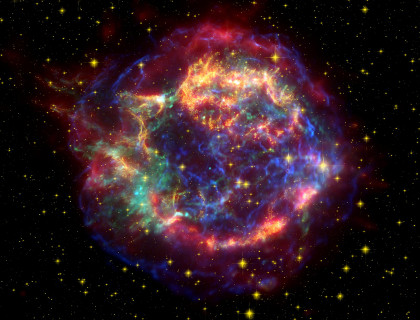Forscher finden Hinweise auf Supernova-Eisen in fossilen Bakterienresten
Nachrichten aus dem Physik-Department - 2013-05-10

In Überresten fossiler, Eisen liebender Bakterien fanden Forscher des Physik-Departments der Technischen Universität München (TUM) und des Exzellenzclusters Universe ein radioaktives Eisenisotop, das nur in Supernovae gebildet wird. Dies ist die erste nachgewiesene biologische Signatur einer Sternenexplosion auf unserer Erde. Die Altersbestimmung des Tiefsee-Bohrkerns aus dem Pazifischen Ozean ergab, dass die Supernova vor etwa 2,2 Millionen Jahren stattgefunden haben muss, also in etwa um die Zeit, als sich der moderne Mensch entwickelt hat.
Der größte Teil der chemischen Elemente in der Natur hat ihren Ursprung im Kernkollaps von Supernovae. Dabei schleudern die Sterne in einer gigantischen Explosion einen Großteil ihrer Masse ins Weltall. Das radioaktive Eisenisotop Fe-60 entsteht fast ausschließlich in solchen Sternenexplosionen. Seine Halbwertszeit ist im Vergleich zum Alter unseres Sonnensystems mit 2,62 Millionen Jahren so kurz, dass es auf der Erde nicht vorkommen sollte. Irdische Spuren wären daher ein Hinweis auf eine Sternexplosion in kosmischer Nachbarschaft. Im Jahr 2004 berichteten Wissenschaftler der TUM erstmals davon, Supernova-Eisen auf dem Grund des Pazifischen Ozeans gefunden zu haben. Das Alter des Fundes wurde auf etwa 2,2 Millionen Jahre datiert.
In den oberen Sedimentschichten der Ozeane lebt eine bestimmte Bakterienart, die in ihren Zellen winzige Magnetit-Kristalle (Fe:sub:3O4) herstellt. Sie besitzen einen Durchmesser von etwa 80 Nanometern. Mit ihrer Hilfe orientiert sich das Bakterium im Erdmagnetfeld. Das aufgenommene Eisen gelangt unter anderem durch Staub aus der Atmosphäre in die Ozeane. Wenn die Erde mit einer Supernova in Kontakt gekommen wäre, so müsste in den fossilen Überresten dieser magnetotaktischen Bakterien Fe-60 zu finden sein, vermutete Shawn Bishop, Astro-Kernphysiker an der TU München.
Um diese These zu überprüfen, untersuchten Shawn Bishop und seine Forscherkollegen 1,7 Millionen bis 3,3 Millionen Jahre alte Teile eines Tiefseebohrkerns aus dem Pazifischen Ozean. Sie entnahmen Proben in einem Abstand von 100.000 Jahren und lösten aus diesen chemisch die fossilen Bakterienreste heraus – und damit auch das möglicherweise enthaltene Supernova-Eisen.
Mit Hilfe des hochempfindlichen Beschleuniger-Massenspektrometers am Maier-Leibnitz-Laboratorium in Garching fanden sie in 2,2 Millionen Jahre alten Proben tatsächlich Fe-60. „Es liegt nahe, dass es sich dabei um die Überreste von Magnetit-Ketten handeln, die von Bakterien auf dem Meeresboden gebildet wurden, als ein Supernova-Regen auf sie niederging“, sagt Shawn Bishop.
Um die vorläufigen Ergebnisse zu bestätigen, bereiten er und sein Team nun die Analyse eines zweiten Bohrkerns vor, der mehr als die zehnfache Menge an Magnetofossilen enthält als der erste Bohrkern. Dabei wollen sie das Fe-60-Signal auch im Zeitverlauf noch genauer analysieren.
- Redaktion
- Petra Riedel, petra.riedel@universe-cluster.de
Veröffentlichung
- APS April Meeting 2013, Volume 58, Number 4
- Nature News, 15. April 2013, DOI: 10.1038/nature.2013.12797
Kontakt
Technische Universität München
Physik Department
Fachgebiet Experimentalphysik - Nukleare Astrophysik
James-Franck-Straße 1
85748 Garching Germany
Tel.: +49 89 289 12437
E-Mail: shawn.bishop@ph.tum.de